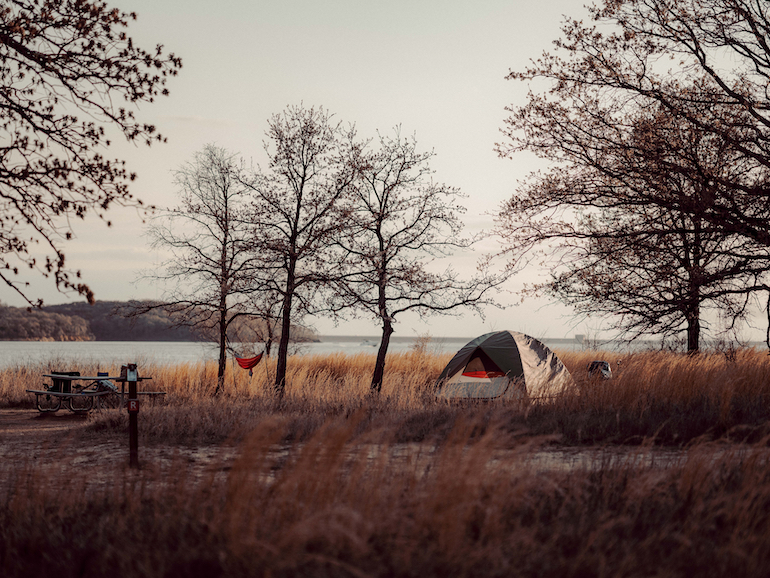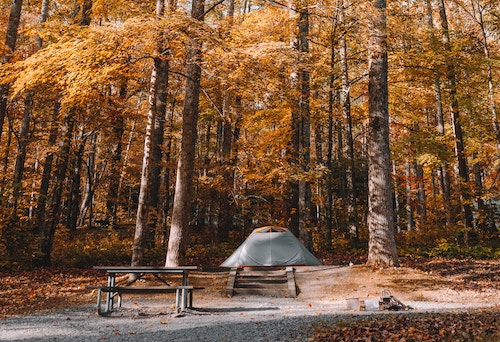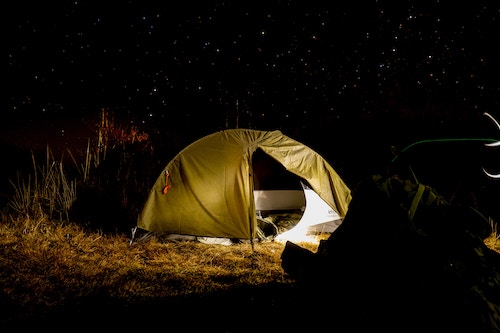ARTICLES
Fall Camping: A Comprehensive Guide to Embracing the Season

Why Choose Fall Camping
Fall is an ideal season for camping for a multitude of reasons:
1. Reduced Crowds: Post-Labor Day, campgrounds are less congested, allowing for a more peaceful and intimate outdoor experience.
2. Mild Temperatures: Autumn days are pleasantly cool, perfect for hiking and outdoor activities, while the evenings offer a comfortable chill that's perfect for campfires.
3. Spectacular Foliage: Witness the breathtaking transformation of leaves into vivid hues of red, orange, and yellow, creating a natural masterpiece.
4. Bug-Free Bliss: Bid farewell to the buzzing and biting insects that often plague summer camping trips as they retreat with the cooler temperatures.
Now, let's delve deeper into the details of planning your fall camping adventure.
Planning Your Fall Camping Trip:
1. Fall Foliage Map: Begin your journey by consulting the Smoky Mountains Fall Foliage Map (covering the entire US). This interactive, annually updated map predicts peak foliage times based on spring and summer weather conditions, providing valuable insights into when and where to witness the vibrant colors.
2. Local Ranger Stations: Don't underestimate the value of local ranger stations. They are a treasure trove of information, offering insights into current foliage conditions, recommended hiking trails with the best autumn colors, and the most suitable campgrounds. A friendly conversation with a ranger can provide invaluable, non-internet-searchable knowledge about the area.
3. Explore Campervans or RVs: Fall's cooler temperatures and changing weather make it an excellent time to try a campervan or RV rental. These options offer added protection and comfort. Explore rental marketplaces like Outdoorsy or Escape Campervans for some fantastic weekend deals.
4. Secure a Campsite Reservation: One of the major perks of fall camping is the ability to secure a reservation on relatively short notice. While many campgrounds are fully booked throughout the summer, availability opens up after Labor Day. Even if spots appear open, consider making a reservation for peace of mind, as this ensures you have a site waiting for you.
5. Site Selection: Maximize your fall experience by choosing a campsite near deciduous trees, which will showcase the vibrant foliage.
Also, check if the campground is open, as some may start scaling down or closing as early as Labor Day. Closure dates can sometimes be weather-dependent, so plan and double-check.
Fall Camping Gear Checklist:
While many summer camping essentials remain applicable, consider these must-have items for a fall camping trip:
· Tent: Opt for a spacious tent with a waterproof rainfly, such as the Eureka Space Camp. The additional room provides comfort for indoor activities in case of rain. Ensure you have a tent footprint or groundsheet if not included.
· Sleeping Bag: Select a sleeping bag rated at least 10°F below expected nighttime lows, or 15°F-20°F below if you tend to get cold easily. A sleeping bag liner can add extra warmth.
· Insulated Sleeping Pad: A sleeping pad with an R-value of at least 4 is essential for fall camping. The higher the R-value, the better. Consider adding a foam pad underneath for increased insulation.
· Tarp and Guylines: Prepare for potential rain by packing a tarp and guylines or a rain shelter.
· Camp Chair: Choose a chair with some padding for added warmth and comfort.
· Extra Blankets: Cozy blankets, such as flannel or fleece, can make a significant difference in staying warm.
· Camp Stove: Ensure your camp stove comes with decent wind protection, and remember to pack your camping cookware and dishes.
· Hatchet and Fire Starting Materials: If campfires are allowed, enjoy cozy evenings by the fire.
· Sit Pads or Cushions: These are great for adding warmth when sitting on picnic benches.
· Headlamps or Lanterns: With shorter daylight hours, reliable lighting is a must for navigating camp after sunset.
· String Lights: Add a touch of portable, rechargeable illumination to your tent, creating a warm and cozy atmosphere.

Setting Up Camp
Properly setting up your campsite in the fall requires some additional considerations:
· Plan for Daylight: As days grow shorter, ensure you arrive with ample daylight remaining to set up your camp. Setting up in the dark can be challenging and less enjoyable.
· Sheltered Locations: If wind is a concern, select a sheltered spot behind trees, bushes, boulders, or even your vehicle to protect against the cold breeze.
· Higher Ground: Opt for higher ground when possible. Cold air tends to settle in low-lying areas, and rain is more likely to pool there. Camping on elevated terrain helps you stay warmer and drier.
· Tarp Usage: Set up a tarp over your picnic table if there's a chance of rain. This provides a dry space for meal preparation and protects against the wind.
Clothing for Camping in the Fall
Fall camping demands clothing that allows for layering and adapting to fluctuating temperatures. Here's a breakdown of the ideal clothing layers:
· Base Layer: Choose a moisture-wicking wool or synthetic base layer to keep sweat away from your skin. Brands like Smartwool offer warm base layer tops and leggings.
· Mid Layer: Include a fleece sweater or lightly insulated jacket for added warmth on cooler days. Popular options include Patagonia's Better Sweater and the Re-Tool Pullover.
· Insulating Layer: When temperatures drop significantly, reach for your insulating layer. A puffy jacket like REI's 650 Down Jacket or Patagonia's Down Sweater is perfect for the task. If the weather isn't extremely cold, consider the Nano Puff.
· Outer Shell: Complete your clothing ensemble with a windproof and waterproof outer shell jacket. These jackets not only trap heat but also protect against wind and rain. The REI Rainier jacket is a reliable choice.
Additional clothing for fall camping
· Rain Gear: In addition to a waterproof jacket, it's wise to pack a pair of rain pants to keep your lower half dry during wet spells.
· Warm Socks: Wool socks are ideal for fall camping, but ensure they're not too bulky inside your shoes. Snug footwear prevents reduced circulation and cold feet.
· Warm Boots/Shoes: Waterproof boots or shoes are the best choice if rain is in the forecast. They also provide additional warmth for your feet.
· Warm Hat/Beanie: Keep your head warm with a cozy hat or beanie.
· Buff, Gaiter, or Scarf: Protect your neck and face from the chill with these versatile accessories.
· Mittens or Gloves: Ensure your hands stay warm during colder evenings.
· Cozy Pajamas: A comfortable set of pajamas will keep you warm throughout the night.
· Extras of Everything: In case items get wet or unexpectedly dirty, have backups for critical items like socks, shoes, a hat, and warm layers.

Staying Warm While Camping in the Fall
Staying warm is a primary concern during fall camping, and here are some strategies to ensure you remain cozy:
· Layer Up: Dress in layers to trap warmth effectively. The ability to add or remove clothing as needed keeps you comfortable in changing conditions.
· Stay Active: Engage in activities throughout the day to maintain your body temperature. Hiking, biking, and other physical pursuits help keep you warm.
· Pre-Bed Warm-Up: Before getting into your sleeping bag, engage in some light physical activity like jumping jacks to warm up your body. Crawling into a warm sleeping bag is much more comfortable.
· Hot Water Bottle: Fill a Nalgene bottle with hot water and place it in your sleeping bag before bedtime. This helps warm up your sleeping bag, ensuring you stay toasty throughout the night. Ensure the bottle is tightly sealed to prevent leaks.
· Warm Tomorrow's Clothes: Place the clothes you intend to wear the next day inside your sleeping bag at night. This preheats your clothes, making them much more comfortable to put on in the morning.
· Morning Warm-Up: Start your day with some light exercises to get your blood flowing and warm up your body. Before exiting your tent, a few jumping jacks can do wonders for your comfort.
· Answer Nature's Call: Don't ignore the call of nature, especially at night. Your body naturally directs less heat to your limbs, including your bladder. By responding promptly, you'll maintain overall warmth.
· Hand & Foot Warmers: Consider packing hand and foot warmers, especially for early mornings. These can provide additional comfort when temperatures drop significantly.
Campfire Safety & Tips
Enjoying a campfire in the fall is a cherished experience, but it's important to do so responsibly:
· Check Local Regulations: Verify local fire regulations and ensure fires are permitted in your area. Some fire bans from the summer may extend into the fall. If open fires are not allowed, consider bringing a propane fire pit with an on/off switch as an alternative.
· Use Existing Fire Rings: Whenever possible, utilize existing fire rings if available. Many established campgrounds provide metal fire rings. If you're dispersed camping, look for a fire ring made of stones that have already been used.
· Proper Fire Placement: Build fires at least 15 feet away from your tent and any flammable objects, such as bushes and trees.
· Extinguish Fires: Never leave a campfire unattended. When you're finished with the campfire, whether it's time for bed, a hike, or leaving the campsite, ensure it is completely extinguished. Properly putting out a fire is crucial for safety; consult an article or guide for detailed instructions on the correct extinguishing process.
Fall Camp Cooking Tips
Fall is the season for hearty meals and campfire cooking. Here are some tips for preparing delicious meals:
· One-Pot Meals: Fall camping calls for warm, hearty dishes, making one-pot, Dutch oven, and foil packet meals ideal choices. These meals are comforting and easier to clean up at the end of the evening.
· Prep Ahead: Prepare ingredients at home before your trip. Since daylight hours are shorter in the fall, having pre-cut and pre-measured ingredients speeds up meal preparation.
· Allow Extra Time: Be prepared for meals to take longer to cook than usual. The cold air and any wind can significantly impact cooking times.
· Extra Fuel: Cooler weather often requires more fuel for cooking. Bring extra canisters or fuel sources to ensure you don't run out.
· Insulated Containers: Invest in double-walled insulated bottles, mugs, and bowls. These items keep your hot beverages and meals warm for extended periods, even in brisk conditions.
Final Thoughts
Fall camping offers an unparalleled blend of natural beauty and outdoor adventure. By planning, selecting the right gear, and following these detailed tips, you'll be well-equipped to savor the splendors of autumn in the great outdoors. So, embark on your fall camping journey, and embrace the enchanting moments that await amid the changing leaves and cooler temperatures. Whether you're seeking vibrant foliage, cozy campfires, or a peaceful escape from the every day, fall camping has something special to offer every outdoor enthusiast.

 Tweet
Tweet Share
Share